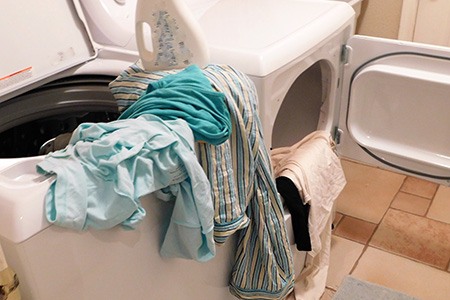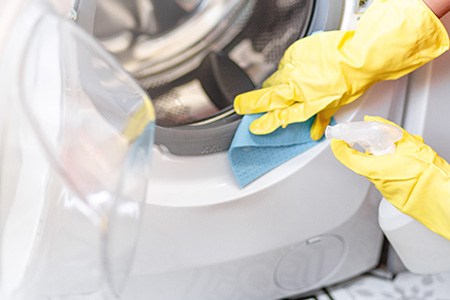Sewer Smell in Your Laundry Room? Here's Why & The Fix
Author: Omar Alonso | Editor: Omar Alonso
Review & Research: Jen Worst & Chris Miller

Does your laundry room smell like an open sewer? It's time to get that under control ASAP. There could be a serious situation behind the scenes, and you have no idea what viruses and bacteria could be spreading through your home. Let's learn all about the sewer smell in your laundry room.
Why is There a Sewer Smell in Your Laundry Room?
Why does my laundry room smell like sewage? The laundry room has the potential to smell like a sewer if there are problems with drainage or ventilation. If you notice a bad smell while doing the laundry, it's usually caused by bacteria. These microbes build up and colonize, creating that terrible odor.
Some causes of this bacterial build-up include blockages in your pipework and drainage system, leaky pipes, and flooding. Laundry rooms are usually small spaces, so you'll notice the smell in a matter of days after the problem starts.
You'll need to identify the cause of the problem before you can get around to eliminating it. When you know what's causing the issue, you can take steps to correct it.
8 Reasons Why There's a Sewer Smell in the Laundry Room
Let’s look at the reasons you could be dealing with this sewage smell in your laundry room. It may be one or a combination, so please go through all of them to make sure you take care of the problem.
1) A Dirty Washer or Dryer

A dirty washer or dryer could be responsible for the smell in the laundry room. Soap scum build-up in the washer provides the perfect environment for bacteria and microbes to grow and colonize. The dryer could also be a potential source of the problem.
The ventilation system might be blocked, or the temperature thermostat is faulty, resulting in inefficient use of the machine and a smell in the laundry room. Keep the washer and dryer clean and in the correct operating order to ensure you never have a problem with bad odors.
Mold and bacteria may grow in the door aperture, the basin, or the lip of the washer. It's a good idea to run the washer on empty. Use a 1/2-cup of baking soda in the drum and a cup of bleach in the bleach compartment next to the detergent.
Don't forget to clean the floors and under your appliances, especially under your pedestals or pedestal alternatives especially if you use anything like that. Many people keep cat litter boxes in the laundry room too, and that sends dust and crumbs everywhere in the room. Clean up regularly!
2) Leaky Pipes

If the washer has a leak in the drainage pipe, it will spill onto the floor behind the machine and start to stink. The drainpipe water mixes with microbes and bacteria, creating an unpleasant smell. It gets worse if you have laminate or wood flooring underneath the washer. These floorings are challenging to clean and may require replacement. In the meantime, when you're going to the laundry mat, here's where to get quarters for the machines.
3) Sewer Issues
Problems with the sewer can cause the sewer smell in your laundry room. If you're dealing with drainage issues of backup, it's likely the culprit. If you have a broken or cracked sewer line, sewage can seep into the laundry room.
Gases from the sewer may enter the drain through a cracked or broken sewer line under the floor. If you notice cracks in the grouting around the drain, the sewer might be the problem. Sewage issues are dangerous to your health due to the mold and mildew they bring into the home.
4) Improper Installation of the P-Trap

Wastewater from the washer flows through a flexible hose into the drain box pipe, connecting to the P-trap. Because there's flexion in the hose, it's possible you or the contractor responsible for installing the system didn't install it properly.
The hose may be inserted too deep into the drainage box, preventing the proper function of the P-trap. The P-trap could be leaking and/or allowing gases to rise back out from your sewage pipes into the laundry room..
5) Clogged Vent Pipes
Washing machines require vent pipes to operate and drain. All drain systems must properly vent to prevent sewer gases from seeping into the home. If the vent pipe is clogged, sewer gases will vent into the laundry room. The odors will come from the walls around the vent pipe.
6) Clogged Drain Lines
If there's a clog in the drain line, it allows water to back up in the machine where it sits inside and starts to smell. If this occurs, you'll have to clear the blockage, or it will continue smelling. Even partial clogs may create sewer smells in the laundry because of bacteria build-up from clogged organic materials. Excess hair and soap scum build-up can clog the drain.
7) Improper Ventilation
Poorly ventilated laundry rooms trap odors. It's important to install an exhaust fan in the room if it's small and the air remains stagnant for long periods. Lack of ventilation exacerbates the sewer smell problem, forcing it to linger.
The laundry room may have venting issues if a clog prevents fumes and gases from moving into the venting pipe. You should also always vent your dryer to the outside of the house to avoid creating an extra warm environment where these bacterias can thrive.
8) Bacteria in Your Water Heater
Well-designed laundry rooms often house the water heater. If you find the smell is only noticeable when you use the hot water, the water heater could be the source of the issue. Sometimes, bacteria may colonize the water heater if the temperature is too low or if you leave it off for long periods. This bacterium is usually not harmful to your health but can create a bad odor.
6 Steps to Stop the Sewer Smell in Your Laundry Room

There are some steps you can take to identify and correct the source of the sewer smell in the laundry room. Here are a couple of tips to help you resolve the issue without calling a professional for help.
Gather the following cleaning materials and then step through the six provided steps to throughly clean everything related to your washing machine, where the stench is likely arising, to completely eradicate that possibility.
Cleaning Materials for Removing Bacteria & Microbes From Your Washing Machine
You can use household items to clean the washing machine. Here are our top choices for the task.
White Spirit Vinegar
White spirit vinegar is remarkably effective for a range of household cleaning tasks. It disinfects surfaces and absorbs odors.
Baking Soda
Baking soda is a fantastic absorbent material that removes odors from the washing machine, pipework, and drains.
Bleach
Bleach is a powerful anti-microbial, killing 99.9% of germs on contact. Combining it with baking soda is incredibly effective. However, don't combine it with vinegar, or you'll create deadly chlorine gas. It can leave behind a different kind of strong odor than the current sewer smell, too, so make sure you know how to get rid of the bleach smell once you're done.
1) Clean the Washer & Dryer

Start with cleaning the washer and dryer. Check that the dryer is operating properly, and its ventilation is operating without obstruction. Next, use a mixture of bleach and baking soda in a 2:1 ratio to scrub out the inside of the washer drum and the plastic lip around the entrance to the machine where dirt and grime build-up.
Ensure the bleach mixture doesn't come into contact with any ammonia cleaning products, as it causes a chemical reaction resulting in the production of Chloramide gas. Clean the inside of the detergent tray and under and around the machine in hard-to-reach areas.
2) Sanitize the Washing Machine Using Bleach
Run the washing machine on a hot cycle with two cups of bleach. You can also add a cup of baking soda to the machine's drum. Baking soda is great at absorbing any unpleasant odors and getting rid of the sewer smell in your laundry room.
The bleach kills bacteria and microorganisms, causing the smell. We recommend doing this practice at least every other month for preventative maintenance in the future, and making sure you know how to dispose of bleach properly.
3) Clean the Drain Lines with Vinegar & Baking Soda
You'll need a deeper cleaning if the smell originates from the drain. If your washing machine drain smells like sewage, using a combination of white spirit vinegar and baking soda is the best choice to sanitize this area. Pour a cup of baking soda into the drain line, followed by a cup of vinegar. The last thing you want is your washing machine walking around and disconnecting the drain and stinking up the place.
You'll notice the combination creates a bubbling reaction that clears any clogs or debris creating blockages, eliminating the smell. You can also mix bleach and baking soda for another cleaning cocktail if the first doesn't get the job done.
4) Examine the Drains & Pipes

If you're not having any luck identifying the problem, check the drains and pipes next. Look for signs of weathering, like cracks or damage to the pipework. If you notice any issues, call a plumber for assistance with fixing the problem to prevent sewage from seeping into the home. Unless you have plumbing experience, call a professional to handle it.
5) Turn Up the Water Heater
If you identify the water heater as the source of the smell, increase the water temperature in the unit. Do this for 24 hours and run the hot taps every few hours throughout the home to flush out the bacteria from the heater. Your water heater can be the hidden reason your laundry room smells like a sewer.
6) Clean the Ventilation System
The ventilation might be the problem if you haven't had any luck identifying the source of the smell elsewhere. If you have windows in the room, open them or turn on the exhaust fan and check it's running properly.
If there's no fan in the laundry room, consider installing one immediately. The exhaust fan vents the gases out of the laundry room instead of letting them linger where they smell.
Check the ventilation pipes on the dryer inside the room and outside on the wall. Use a vacuum cleaner to clear any blockages. Don't vent the dryer into your garage or you'll just be sending stinking air into there instead, among other problems related to doing that.
Fix That Sewer Smell in Your Laundry Room ASAP
Call a plumbing professional for assistance if you're out of your depth. Only mess around with the sewer lines and pipework if you know what you're doing. Don't let the problem fester. You risk the health of yourself and your family by allowing it to worsen.
A preventative maintenance strategy is a great idea to prevent issues with clogs in pipes and scum build-up in the machine that cause the onset of the sewer smell in the laundry room. Clean the appliance and lines every other month, and you won't have to worry about calling the plumber or that lingering sewer smell in your laundry room.



